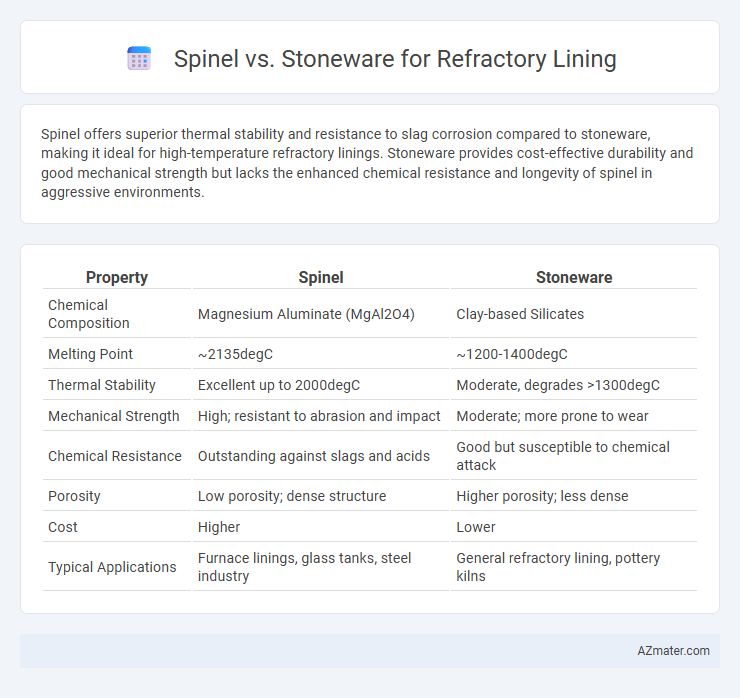Spinel offers superior thermal stability and resistance to slag corrosion compared to stoneware, making it ideal for high-temperature refractory linings. Stoneware provides cost-effective durability and good mechanical strength but lacks the enhanced chemical resistance and longevity of spinel in aggressive environments.
Table of Comparison
| Property | Spinel | Stoneware |
|---|---|---|
| Chemical Composition | Magnesium Aluminate (MgAl2O4) | Clay-based Silicates |
| Melting Point | ~2135degC | ~1200-1400degC |
| Thermal Stability | Excellent up to 2000degC | Moderate, degrades >1300degC |
| Mechanical Strength | High; resistant to abrasion and impact | Moderate; more prone to wear |
| Chemical Resistance | Outstanding against slags and acids | Good but susceptible to chemical attack |
| Porosity | Low porosity; dense structure | Higher porosity; less dense |
| Cost | Higher | Lower |
| Typical Applications | Furnace linings, glass tanks, steel industry | General refractory lining, pottery kilns |
Introduction: The Importance of Refractory Lining Selection
Refractory lining selection significantly impacts the durability and thermal efficiency of industrial furnaces and kilns. Spinel offers excellent resistance to thermal shock and chemical corrosion, making it ideal for high-temperature environments. Stoneware provides cost-effective abrasion resistance but may fall short in extreme thermal cycles compared to spinel composites.
Understanding Spinel: Composition and Properties
Spinel, a magnesium aluminate mineral (MgAl2O4), exhibits exceptional thermal stability and mechanical strength, making it ideal for refractory lining applications in high-temperature environments. Its crystalline structure provides excellent corrosion resistance and resistance to slag attack, outperforming traditional stoneware in durability and lifespan. These properties enable spinel to maintain structural integrity under extreme thermal cycling and chemical exposure, ensuring enhanced performance and reduced maintenance costs in refractory systems.
Stoneware Overview: Characteristics and Applications
Stoneware exhibits high durability and thermal shock resistance, making it ideal for refractory lining in industrial furnaces. Its dense, non-porous composition ensures excellent resistance to chemical corrosion and mechanical wear under high-temperature conditions. Common applications include kiln linings, heat exchangers, and other environments requiring robust thermal insulation and structural integrity.
Thermal Resistance Comparison: Spinel vs Stoneware
Spinel offers superior thermal resistance compared to stoneware, maintaining structural integrity at temperatures exceeding 1600degC, whereas stoneware typically withstands up to 1300degC. Spinel's crystalline structure enhances its resistance to thermal shock, making it ideal for high-temperature applications in refractory linings. Stoneware, while durable, is more susceptible to cracking under rapid temperature fluctuations, limiting its use in extreme thermal environments.
Mechanical Strength and Durability Analysis
Spinel exhibits superior mechanical strength compared to traditional stoneware, making it highly resistant to thermal shock and mechanical wear in refractory lining applications. Its increased durability stems from a dense crystalline structure that enhances resistance to abrasion and corrosion under high-temperature conditions. Stoneware, while cost-effective, generally provides lower mechanical resilience, leading to faster degradation in intense industrial environments.
Chemical Corrosion Resistance in Harsh Environments
Spinel exhibits superior chemical corrosion resistance compared to stoneware in harsh refractory lining environments due to its stable, dense crystalline structure and high thermal stability, effectively resisting alkali and acidic slags. Stoneware, while durable, is more prone to chemical erosion and degradation when exposed to aggressive molten slags and fluctuating temperatures encountered in industrial furnaces. The enhanced corrosion resistance of spinel reduces maintenance frequency and extends the service life of refractory linings in metallurgical and cement industries.
Installation Techniques and Lining Longevity
Spinel refractory linings, known for their high thermal stability and resistance to slag corrosion, require precise installation techniques such as dry gunning or castable application to ensure optimal bonding and minimal porosity, enhancing lining longevity in high-temperature environments. Stoneware linings, typically installed through traditional cast or pressed methods, offer excellent durability against mechanical wear but may be more susceptible to thermal shock compared to spinel, impacting their service life. Proper surface preparation and controlled curing processes significantly influence the performance and lifespan of both spinel and stoneware refractory linings in industrial applications.
Cost Efficiency: Initial Investment vs Lifecycle Value
Spinel offers superior thermal stability and wear resistance for refractory lining but comes with a higher initial investment compared to stoneware. Stoneware provides a more cost-effective upfront option with reasonable durability, resulting in lower installation expenses. Over the lifecycle, spinel's enhanced longevity and reduced maintenance needs often deliver greater overall cost efficiency despite its initial price premium.
Application Suitability by Industry and Process
Spinel refractory linings exhibit superior resistance to thermal shock and chemical corrosion, making them ideal for steelmaking and cement production where high-temperature stability is critical. Stoneware linings offer excellent abrasion resistance and mechanical strength, suitable for glass manufacturing and petrochemical processes that involve less aggressive thermal conditions. Selecting between spinel and stoneware depends on the specific operational environment, with spinel favored for extreme heat and chemical exposure, while stoneware fits applications requiring durability under moderate temperatures.
Conclusion: Choosing the Optimal Refractory Lining Material
Spinel offers superior thermal stability and resistance to chemical attack, making it ideal for high-temperature refractory linings exposed to aggressive slags and molten metals. Stoneware provides cost-effective durability with good mechanical strength but lacks the advanced thermal shock resistance of spinel composites. Selecting the optimal refractory lining hinges on balancing performance requirements, operational temperatures, and budget constraints, with spinel favored for demanding industrial applications.

Infographic: Spinel vs Stoneware for Refractory Lining
 azmater.com
azmater.com